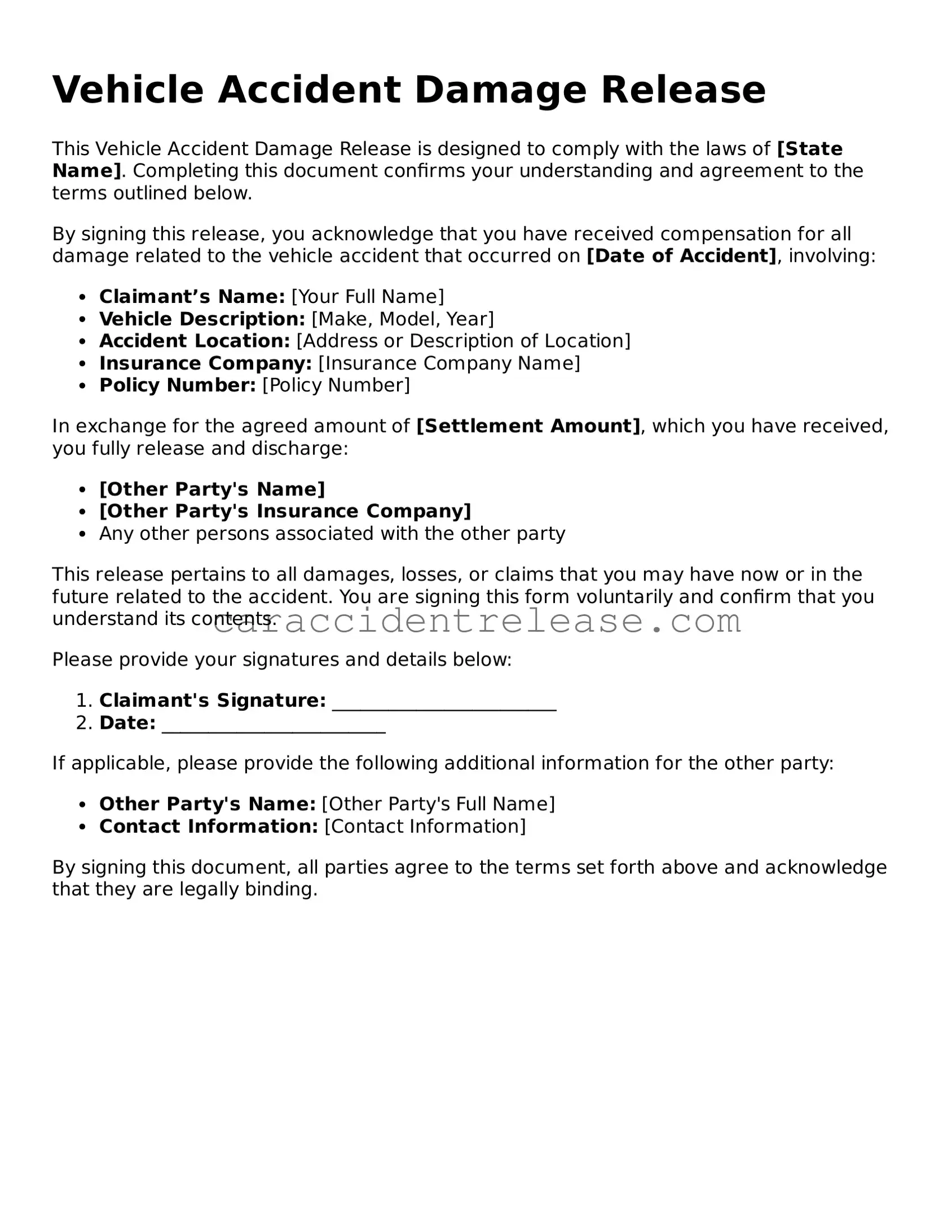The Vehicle Accident Damage Release form shares similarities with the Waiver of Liability form. Both documents are designed to protect one party from legal claims or liabilities arising from specific activities or incidents. In a vehicle accident context, the release form allows the party at fault to avoid future claims for damages, while a waiver of liability can be used in various scenarios, such as sports or recreational activities. Both documents require the signing party to acknowledge the risks involved and agree not to hold the other party responsible.
Another document that resembles the Vehicle Accident Damage Release form is the Settlement Agreement. This document is often used when two parties reach a compromise after a dispute. Like the release form, a settlement agreement typically includes terms that prevent further legal action regarding the same issue. In the case of a vehicle accident, a settlement agreement would outline the compensation agreed upon by the parties, while the release form ensures that the party receiving compensation cannot later pursue additional claims.
The Indemnity Agreement also parallels the Vehicle Accident Damage Release form. An indemnity agreement involves one party agreeing to compensate another for any losses or damages that may arise. This is similar to a release form in that it seeks to protect one party from financial responsibility. In the context of vehicle accidents, the indemnity agreement would require the at-fault driver to cover the costs incurred by the other party, similar to how a release form prevents further claims.
The Hold Harmless Agreement is another document that functions similarly to the Vehicle Accident Damage Release form. This agreement explicitly states that one party will not hold the other responsible for any damages or injuries that may occur. In the event of a vehicle accident, a hold harmless agreement can serve to protect the at-fault driver from being sued by the other party, much like the release form. Both documents aim to clarify the responsibilities of each party involved.
The Liability Release form is closely related to the Vehicle Accident Damage Release form. This document allows individuals to waive their right to sue for damages resulting from an accident or injury. In the context of vehicle accidents, a liability release would prevent the injured party from pursuing legal action against the driver at fault. Both forms serve to limit legal exposure and clarify the expectations of the parties involved.
In navigating investment opportunities, it is also important to consider the foundational documents that outline the financial intentions between parties. One such crucial document is the Investment Letter of Intent form, which serves as an initial agreement indicating serious interest and paving the way for more detailed negotiations in investment dealings.
The Consent to Treat form also shares some similarities with the Vehicle Accident Damage Release form. This document is often used in medical settings, allowing healthcare providers to treat a patient while releasing them from liability for any complications that may arise. In the aftermath of a vehicle accident, a consent to treat form can help ensure that medical professionals are not held liable for any adverse outcomes, similar to how a release form protects drivers from future claims.
The Non-Disclosure Agreement (NDA) has elements that overlap with the Vehicle Accident Damage Release form, particularly regarding confidentiality. While NDAs are primarily used to protect sensitive information, they can also prevent parties from discussing the terms of a settlement after a vehicle accident. Both documents serve to protect the interests of one party, ensuring that certain information remains private and that future claims are minimized.
The Release of Claims form is another document that is quite similar to the Vehicle Accident Damage Release form. This form is often used to relinquish any claims one party might have against another. In the context of a vehicle accident, the release of claims would ensure that the injured party cannot seek further compensation once an agreement is reached. Both forms focus on finalizing the legal responsibilities of the parties involved and preventing future disputes.
Finally, the Agreement to Arbitrate can be seen as analogous to the Vehicle Accident Damage Release form in that it seeks to resolve disputes outside of the courtroom. By agreeing to arbitration, parties can avoid lengthy legal battles, similar to how a release form can prevent future claims. In the event of a vehicle accident, an arbitration agreement would outline how disputes will be handled, providing a framework for resolution without the need for litigation.
